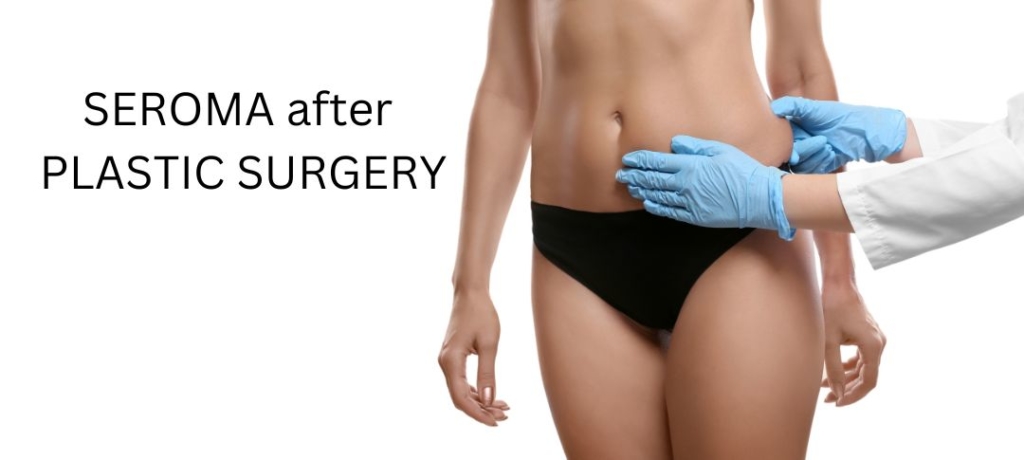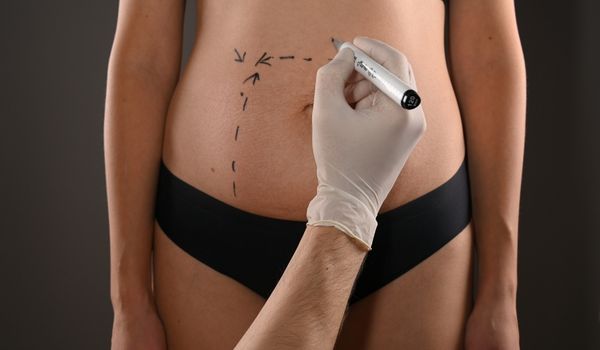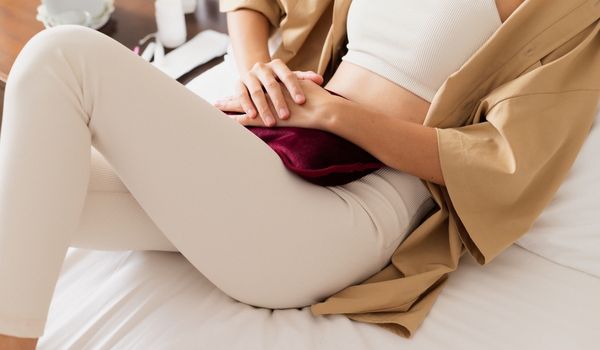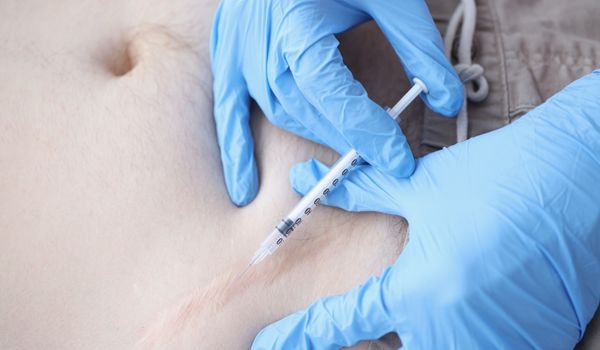
Seroma – Causes, Treatment, And Prevention
A seroma is a collection of clear fluid under the skin that commonly occurs near incision sites after surgery. You can develop a fluid build up right after your plastic surgery, or the fluid can build up weeks after your procedure.
Most seromas go away by themselves or are drained with a needle and a syringe. More persistent fluid build up may require surgical removal or antibiotic treatment if they become infected.
You’re less likely to develop a post-op seroma if you get surgical drains, wear compression garments, limit your movement during initial recovery, or get steroid wound injections.
Find out more about what causes fluid build up, their symptoms, how you can treat them, and how you can avoid them.
What Are Seromas?
A seroma is a lump of clear fluid that collects under the surface of the skin. It’s one of the most common complications following plastic surgery and often forms near the surgical incision site or where the tissue was removed.
They are made up of “serous fluid” or “serum”- a clear liquid that seeps out of ruptured small blood vessels and injured cells. The fluid may collect under the skin right away after surgery, or it may start building up weeks after.
How Do Seromas Develop?
During plastic surgery, your surgeon may remove excess tissue and skin from your body. The removal of tissue creates an empty space between tissues known as dead space.
Nearby lymphatic vessels, which might become damaged during surgery, can start leaking into this space and filling it up with fluid. If the oozing fluid doesn’t drain properly, it can pool under the skin and form a pocket of fluid after plastic surgery.
What Are The Symptoms Of Seroma?
A seroma may cause the following symptoms:
- A soft and swollen bulge near the surgical wounds
- A clear fluid discharge onto the surface of the skin
- Pain and inflammation in the area surrounding the fluid build up (if it is large)
- Redness, warmness, and tenderness in the skin (if it becomes infected)
Seromas often shrink and resolve on their own. They can, however, become infected and develop into an abscess. The symptoms of an infected abscess include:
- Pus discharge (a thick fluid containing dead tissue, cells, and bacteria)
- Fever and chills
- Changes in blood pressure
- Heart palpitations and rapid breathing
- Mental confusion
Which Plastic Surgeries Can Cause Seromas?
A postoperative seroma can develop after many procedures, including plastic surgery. The most common types of plastic surgeries that can lead to the development of fluid build up are:
- Liposuction
- Abdominoplasty and/or hernia repair
- Breast lift
- Arm, thigh, or butt lift
What Are the Risk Factors of Seroma?
Some factors can increase the risk of developing fluid build up after a cosmetic surgery, such as:
- Undergoing an extensive surgery that affects a large portion of your tissues (such as abdominal wall reconstruction or tummy tuck)
- Undergoing a plastic surgery that requires the removal of a substantial amount of excess fat and skin (such as abdominoplasty or liposuction)
- Removing your surgical drainage tubes earlier than recommended
- Having a history of seromas following surgeries
Having one or more of these risk factors doesn’t necessarily mean you will have fluid build up after your surgery, but it does increase your likelihood of developing seromas.
How Can You Identify a Seroma?
You can spot a post-op seroma yourself:
- You’ll notice a swollen fluid-filled bulge near your wounds
- It may feel sore or tender to touch
- A clear fluid discharge may ooze out of it from time to time
- The fluid discharge may change colour, develop an odour, or become bloody if the seroma becomes infected
- In rare cases, the seroma may calcify and feel like a hard knot under your skin
Your surgeon or physician can also identify a post-surgical seroma during a physical examination.
If the physical examination was inconclusive, a bedside ultrasound or a computed tomography (CT) scan helps your physician better visualize and locate the seroma.
How Is Seroma Treated After Plastic Surgery?
Seroma management depends on how much fluid has pooled under the skin and whether the pocket of fluid becomes infected.
1. Treatment of small seromas after plastic surgery
Most small seromas don’t require medical treatment- the body naturally reabsorbs the fluid within a few weeks or months. In some cases, it can take as long as a year to recover from a post-op seroma.
Patients with minor seromas after a tummy tuck, breast lift, and other cosmetic surgeries may take over-the-counter pain meds such as ibuprofen. The non-steroidal anti-inflammatory drugs can help decrease pain and discomfort and reduce the inflammation from the seroma.
If the seroma becomes painful, grows bigger, or becomes infected, it may need medical treatment by a healthcare professional.
2. Treatment of large seromas after plastic surgery
A seroma needs to be drained if it starts getting bigger or becomes bothersome. Seromas can be drained by a procedure known as aspiration.
During an aspiration, a needle is inserted into the seroma and the fluid is removed with a syringe. Multiple aspirations can be done if the first one does not completely drain the seroma.
You can also apply compression bandages to the area affected by seroma to reduce swelling and pain and prevent the seroma from refilling.
3. Treatment of persistent seromas after plastic surgery
In rare cases, the post-surgical seroma doesn’t go away despite multiple drainage attempts. Persistent or returning seromas may require a minor surgical procedure to remove the fluid pocket entirely.
Another option for resolving persistent postoperative seromas is sclerotherapy.
During sclerotherapy treatment, an irritant is injected into the empty space between healing tissues. The irritant then causes minor inflammation which can promote the healing of your tissues and close up the empty space between them.
4. Treatment of infected seromas
If you have a persistent seroma that becomes infected and full of pus, you’ll probably need antibiotics and abscess drainage to improve the symptoms of infection.
Natural ways to treat a seroma
You can take a few steps to help the seroma reabsorb faster after your plastic surgery, and prevent it from worsening.
Some of the best natural ways to help get rid of a seroma are:
- Apply heat: apply a heating pad or a warm compress to the seroma. The heat can help increase fluid drainage and reduce the swelling and soreness in that area. First, adjust the temperature of the compress (make sure it’s not too hot). Then, place it on the seroma for only around 10 minutes. Finally, repeat this at least three times a day. Note that seroma heat treatments can take up to six weeks before resulting in any improvements. Keep on applying heat and contact your surgeon if the seroma gets bigger
- Elevate the affected area: try to keep the area affected by a seroma elevated, this can help the fluid drain faster
- Limit your activity: too much activity after surgery can slow down your healing which gives a seroma more time to refill. After your surgical procedure, avoid strenuous or vigorous activity to improve your healing, repair the space between your tissue, and help get rid of seromas faster
- Maintain good hygiene: if a seroma gets infected, it can become a serious complication. You must keep the area affected by the seroma clean, especially your surgical incisions. Wash your hands carefully before touching your incisions or seroma, and don’t apply a compress unless you’re sure it’s clean. This will help keep out bacteria and other microbes and prevent the seroma from getting infected and worsening
- Take care of your drainage tubes: follow your surgeon’s instructions on how to take care of your surgical drains. Keep your drains clean and wash your hands thoroughly before changing them. Also, be careful not to lean or sleep on the tubes to avoid any drainage obstruction
How to Prevent Seroma
Several steps can help prevent a seroma from forming after plastic surgery:
· Surgical drains
Your surgical team can insert drainage tubes around your incision and try to avoid seromas.
The surgical drains remain in your body for a few hours or a few days following abdominoplasty or a thigh lift to reduce the amount of draining fluid and prevent its build up under the skin.
In most cases, drains are enough to prevent a seroma from forming. However, a seroma can develop weeks after surgery, especially if you remove your surgical drains earlier than recommended.
· Compression garments
A compression garment is a medical piece of clothing that fits tightly around the body.
The compression from the garment puts pressure on the tissues and helps reduce soreness and swelling. The garment also raises the skin and tissue temperature which promotes blood flow and helps your tissue heal.
Wearing compression garments after plastic surgery can help your skin and tissue heal faster and reduce the risk of developing a seroma. You might need to wear a compression garment after breast reduction, breast lift, and tummy tuck, for example.
· Limit your movement
The most important phase of wound healing happens in the few days after surgery. During the initial days of recovery, patients must minimize their movement to avoid straining their wounds.
If you move excessively in the early days following your surgery, your wounds won’t be able to heal as fast as they should. And the longer it takes for your wounds to heal, the longer you’ll have empty space between your tissues, and the more likely you’ll develop a seroma.
Therefore, minimising the patient’s movements in the initial recovery can improve wound healing and reduce the risk of developing seromas.
Keep in mind that light walking alone is still encouraged and should not affect the wound healing process.
· Suturing techniques
Experienced plastic surgeons use advanced suturing techniques to prevent seromas after plastic surgery.
For example, the quilting suture technique relies on suturing the skin flaps to the underlying muscle tissue to reduce the dead space between them. Consequently, you’ll have a lower risk of developing a seroma after a tummy tuck if your surgeon uses quilting sutures.
· Steroids
Wound steroid injections can help prevent seromas after some types of plastic surgery procedures.
Injecting steroids into the surgical wound reduces inflammation and prevents the fluid from pooling. Consequently, steroids can make it less likely for a seroma to form.
What Happens If You Don’t Treat a Seroma?
If a seroma remains untreated for a long time, a fibrous capsule (a thin layer of tissue) may form around it. As a result, the seroma becomes harder to drain, and fluid starts pooling in quickly.
In such cases, frequent drainage will be necessary, and sometimes even the surgical removal of the seroma.
An untreated postoperative seroma could also become infected and develop into an abscess resulting in a high fever, redness, and pain in the affected area.
Are Seromas a Dangerous Complication?
Seromas are usually not dangerous. Most seromas resolve on their own or are drained with a simple aspiration. They can, however, cause some pain and discomfort.
Nevertheless, if a seroma persists for a long time and becomes infected, it can develop into an abscess (a painful lump full of puss) which could cause fever and for the seroma to become red and painful.
You should seek medical advice if you notice a lump under your skin near your wounds after plastic surgery and you start experiencing symptoms of an infection.
Medical References about Seroma after Plastic Surgery
- Seroma Formation after Mastectomy: Pathogenesis and Prevention – PMC
- Management of abdominal wall recurrent subfascial seroma after pelvic surgery – PMC
- Techniques in the prevention and management of seromas after breast surgery
- Recovery after Surgery by Dr Carmen Munteanu
- Breast DIEP Sydney by Dr Bish Soliman
- Plastic Surgery Risks and Complications by Dr Guy Watts
- Plastic Surgery Risks and Complications by Dr Michael Kernohan
- How To Choose The Best Compression Garments After An Abdominoplasty




